|
Welcome to our interview blog post featuring eight dynamic women who are leading the way in the hospital-at-home field. These innovative professionals are revolutionizing patient care by bringing hospital-level treatment directly to patients' homes. Join us as we explore their insights and experiences in this evolving area of healthcare delivery.
- Briefly share your experience in the HaH field.
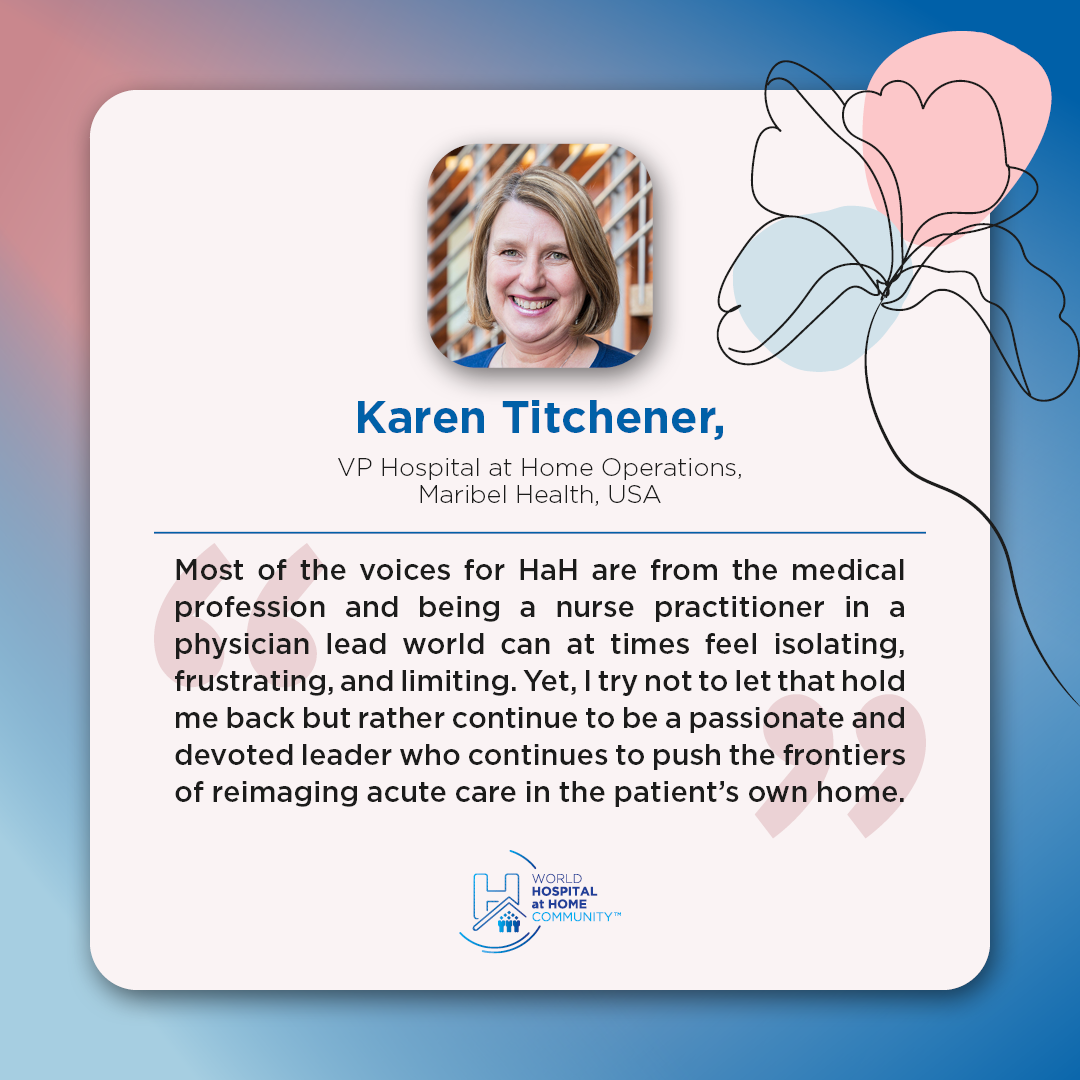
Karen Titchener, VP Hospital at Home Operations, Maribel Health (USA): I have had more than 22 years of experience in developing and implementing over seven Hospital at Home programs in both urban and rural settings for both the UK’s National Health Service (NHS) and seven years in the USA. I was the clinical lead in the development and operations of a HaH program with a 10 million pound a year budget, more than 85 staff, and more than 3,000 annual patient admissions with an ADC of 90-100 patients aged 18+. I also lead the implementation of one of the world’s first Oncology Specialty Hospital at Home programs.
Vittoria Tibaldi,
Head, Section of Geriatrics, AO S. Croce e Carle Hospital of Cuneo (Italy): I started my experience with Hospital at Home during my studies at university, approximately 25 years ago. At that time the manager of HaH was Doctor Nicoletta Aimonino, who was also my “teacher“. Nicoletta Aimonino was deeply passionate about her work and very competent. She passed the love for this special type of work on to me. Working outside the “comfort zone” of the hospital is challenging and stimulating, and this is what still today gives me a lot of satisfaction and motivates me to continue my work.
Nicoletta Aimonino,
One of the first International Leaders in the field of
Hospital at Home, Former Head of the Hospital at Home Service, AOU Città della Salute e della
Scienza of Turin Hospital (Italy): In 1985 I started working at Turin’s Hospital at Home Service at the University Institute of Geriatrics, directed by Prof. Fabrizio Fabris. I was responsible for this service until 2013. The beginning was “pioneering” (few nurses, instruments, cars, etc.), but I strongly believed in being able to offer HaH to the community, especially to the pluripathological and/or frail patients.
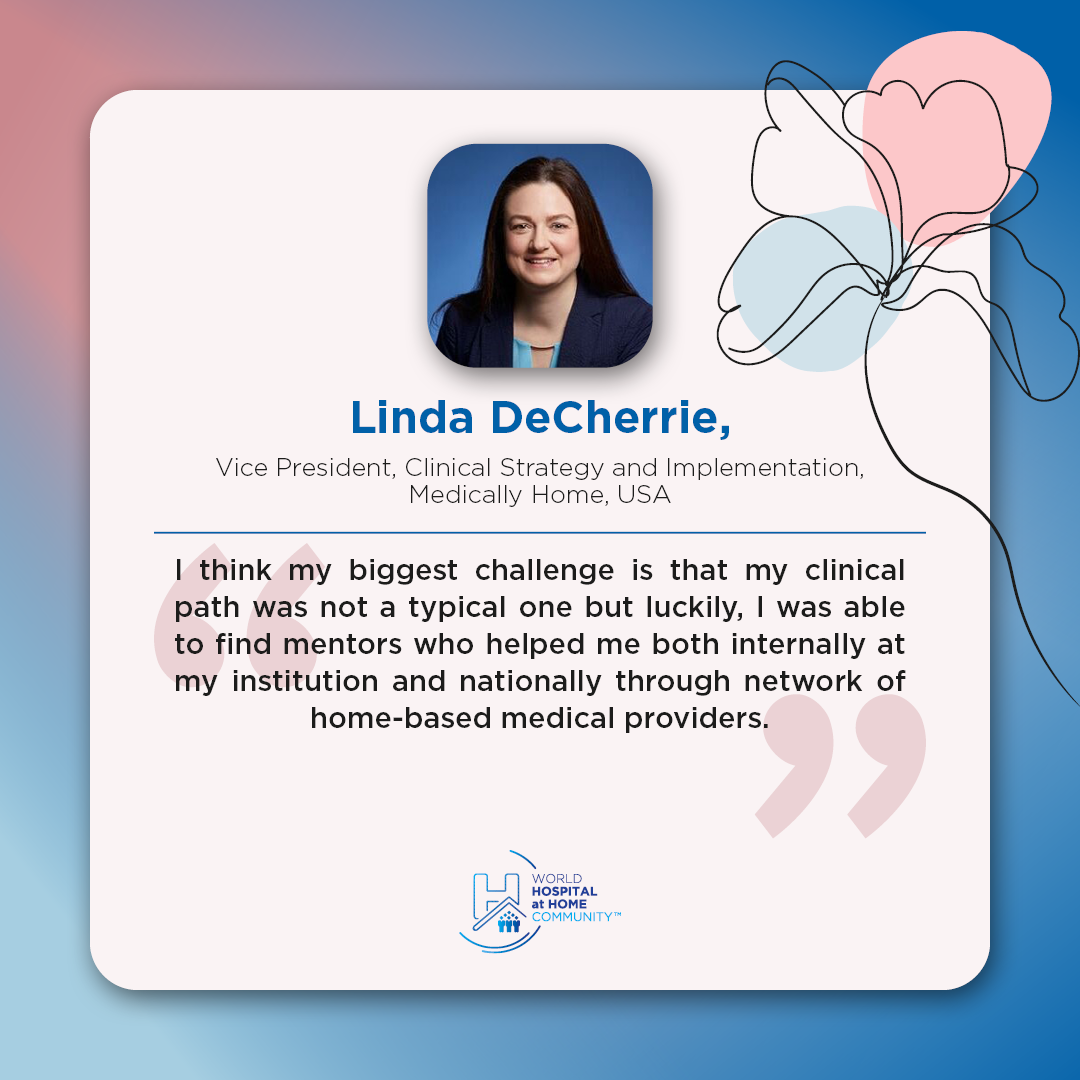
Linda DeCherrie, Vice President, Clinical Strategy and Implementation,
Medically Home (USA): My professional passion is home-based medical care. I am a geriatrician by training and had some early experiences with home visits before medical school and again in residency. When I finished training my first job was with the Mount Sinai Visiting Doctors which provides primary and palliative care to home-bound older adults in Manhattan and exclusively does that through home visits. Through that amazing experience I was able to see the possibilities of home-based medical care and helped develop a home-based palliative care service and a pediatric house calls program and then ultimately the Mount Sinai Hospital at Home program. I transitioned to Medically Home which operates acute care at home programs more than two years ago because I wanted to bring the Hospital at Home program to many more places in the US. I am the VP of Clinical Strategy and Implementation, leading the team of physicians and nurses who partner with health systems from implementation to ongoing operations.
Michelle Grinman, Clinical Associate Professor, Deputy Section Lead,
General Internal Medicine, Cummings School of Medicine, University of Calgary (Canada): I have led the creation of one of the first HaH programs for a general medical population in Canada and am now supporting the expansion of this model across the province of Alberta. I also lead the Canadian Hospital at Home Working Group that is supporting HaH leaders across Canada. This work has been incredibly rewarding, with endless learning about new clinical models and technology, as well as the opportunity to collaborate with innovative leaders locally and worldwide.
Sophie McGlen, Highly Advanced Pharmacist for Virtual Wards, Oxford University
Hospitals NHS Foundation Trust (UK): I joined the Oxford University Hospitals Hospital at Home team in 2017 having previously been a respiratory specialist pharmacist.
Stephanie Ko, Consultant, Advanced Internal Medicine, National University Health
Systems (Singapore): I am an internal medicine specialist and have spent my entire training taking care of hospitalized patients. I first came across hospital-at-home in 2017 as an alternative to ward-based hospitalization and later started getting involved in starting my hospital's HAH program in 2020, NUHS@Home. I now have the privilege of working with an incredible team of thought leaders across different disciplines to lead a 35-bed unit in Western Singapore, with plans to expand further over the next few years.
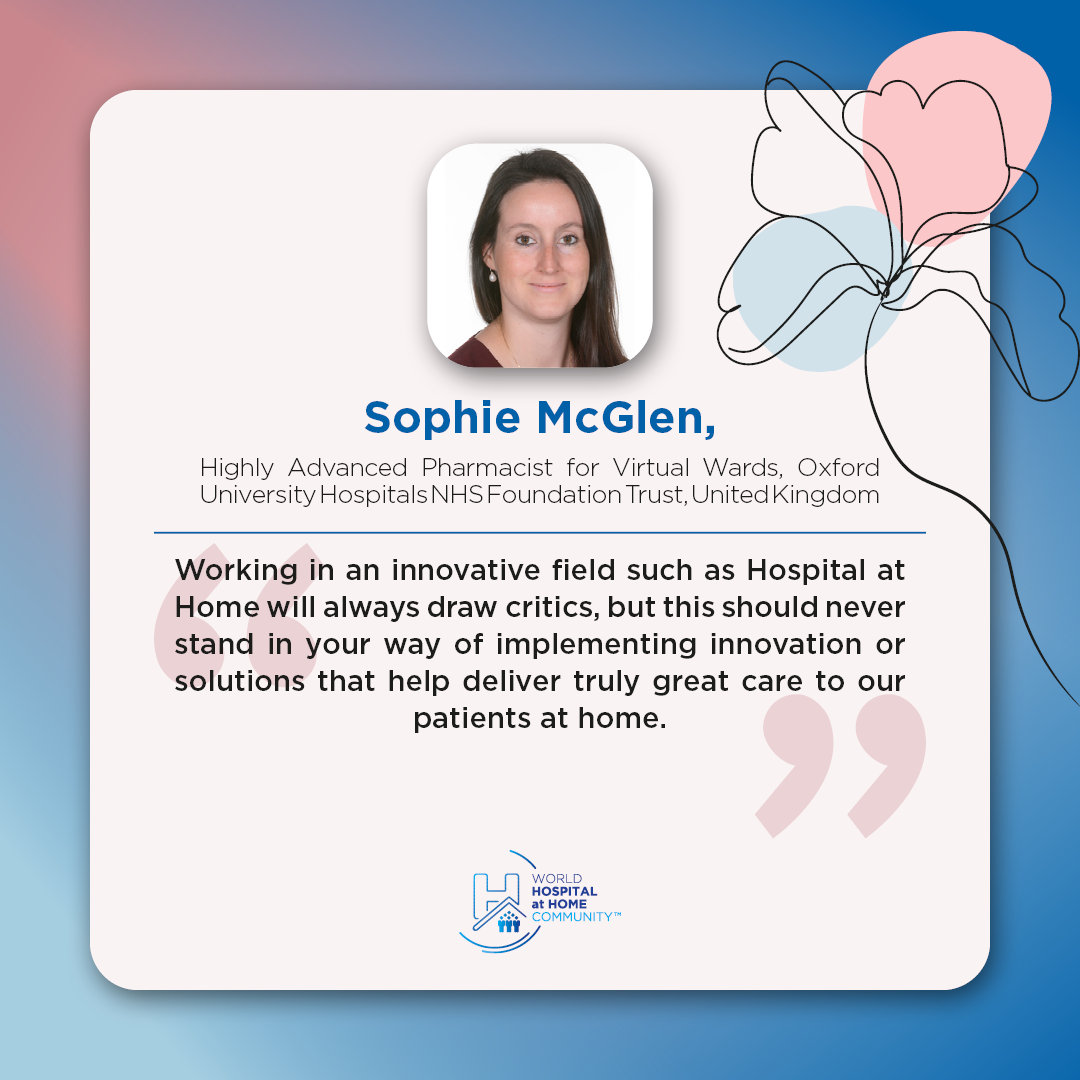
Beatriz Massa, Chief Hospital at Home Section, Heath Department
Elche-Hospital General (Spain): After years working in a hospital emergency service and internal medicine ward, I was tasked with launching HaH in a regional hospital where I worked for 7 years, later moving as Head of HaH service in a tertiary hospital. In those first years... I ran the autonomous scientific society of HaH, of which I was president for 8 years, and then assumed the presidency of SEHAD from 2016 to 2020. In 2019, I was part of the Organizing Committee of the 1st World Hospital at Home Congress.
HaH, it has allowed me a more egalitarian relationship with the patient, participating in decision-making regarding their disease, while offering quality, safe and efficient healthcare for the healthcare system. It is the healthcare model that best guarantees covering the care gaps between the hospital and primary care.
- What are some of the challenges you have faced in your career path?
Karen Titchener: The main challenge with leading HaH is recruiting the right team members. HaH is not for everyone with the fast pace and unpredictable nature of the program. So, finding clinicians that fit the program requires expert recruitment strategies. Alongside recruiting the right clinician is developing an in-depth HaH-specific onboarding and training.
I truly love my medical colleagues in HaH and HaH would not be where it was and is without them. Most of the voices for HaH are from the medical profession and being a nurse practitioner in a physician-led world can at times feel isolating, frustrating, and limiting. Yet, I try not to let that hold me back but rather continue to be a passionate and devoted leader who continues to push the frontiers of reimaging acute care in the patient’s own home.
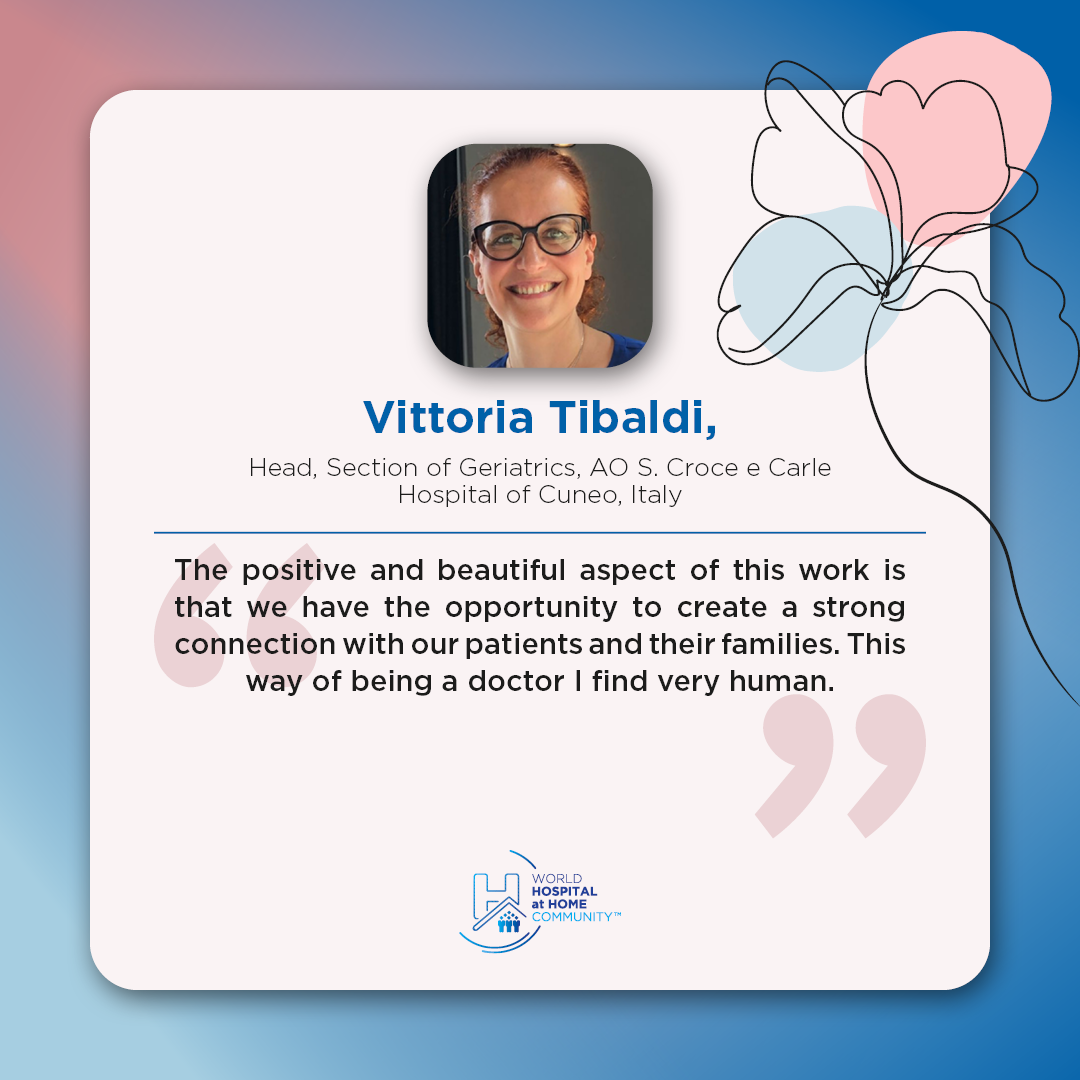
Vittoria Tibaldi: It has always been one of the biggest challenges to make people understand what Hospital at Home is - and what we do in patient’s homes - and to overcome perplexities or doubts of colleagues working in other care settings or people involved in the organization of health services and politicians. I have often felt alone and have had the sensation of rowing against the current. The birth of a Hospital at Home international group has helped reduce this sense of loneliness, making me feel part of a community.
Nicoletta Aimonino: I accepted many challenges to overcome general skepticism towards this kind of hospital care model that at that time was so innovative and revolutionary. I accepted personal challenges too: my daughter was very young at that time and at the beginning of my work in this service I was often very busy working 24 hours a day.
Linda DeCherrie: I think my biggest challenge is that my clinical path was not a typical one but luckily, I was able to find mentors who helped me both internally at my institution and nationally through a network of home-based medical providers.
Michelle Grinman: When I first proposed the HaH model in Canada, it was considered an unknown entity that was somewhat divisive. Some stakeholders viewed this as an opportunity to improve our healthcare system and patient care. Other people worried about safety and resource allocation for an initially small number of patients. Developing enough supportive evidence to establish proof of concept, and my participation in the international HaH community, were vitally important as a female leader challenging the status quo and trying to change our practice culture.
Sophie McGlen: The concept of Hospital at Home was relatively new to the organization when I joined the team and one of the most frequent comments I received was ‘Your patient is at home, they can’t be that sick!’. Helping those external to the service to view the Hospital at Home patients in the same way as hospital inpatients has been a challenge. However, it was important to me to ensure that our patients receive the level of pharmaceutical care required as starting, stopping, or changing medications is one of the most common interventions enacted by our team. I have done this slowly over 5 years, using patient cases, service data, and feedback from the rest of the MDT to demonstrate why having pharmacists involved in the team is so important.
The role of the pharmacist was also not well established when I started, however, this gave me the freedom to work out where my skills fit best within the team. Pharmacists can sometimes have a reputation for being obstructive when it comes to pushing the boundaries of medication delivery, however, they also have a unique skill set to be able to facilitate it within the Hospital at Home setting. I’ve worked hard to engage with pharmacists across my department to find ways to deliver medications in the home setting while complying with the relevant guidelines and legal requirements.
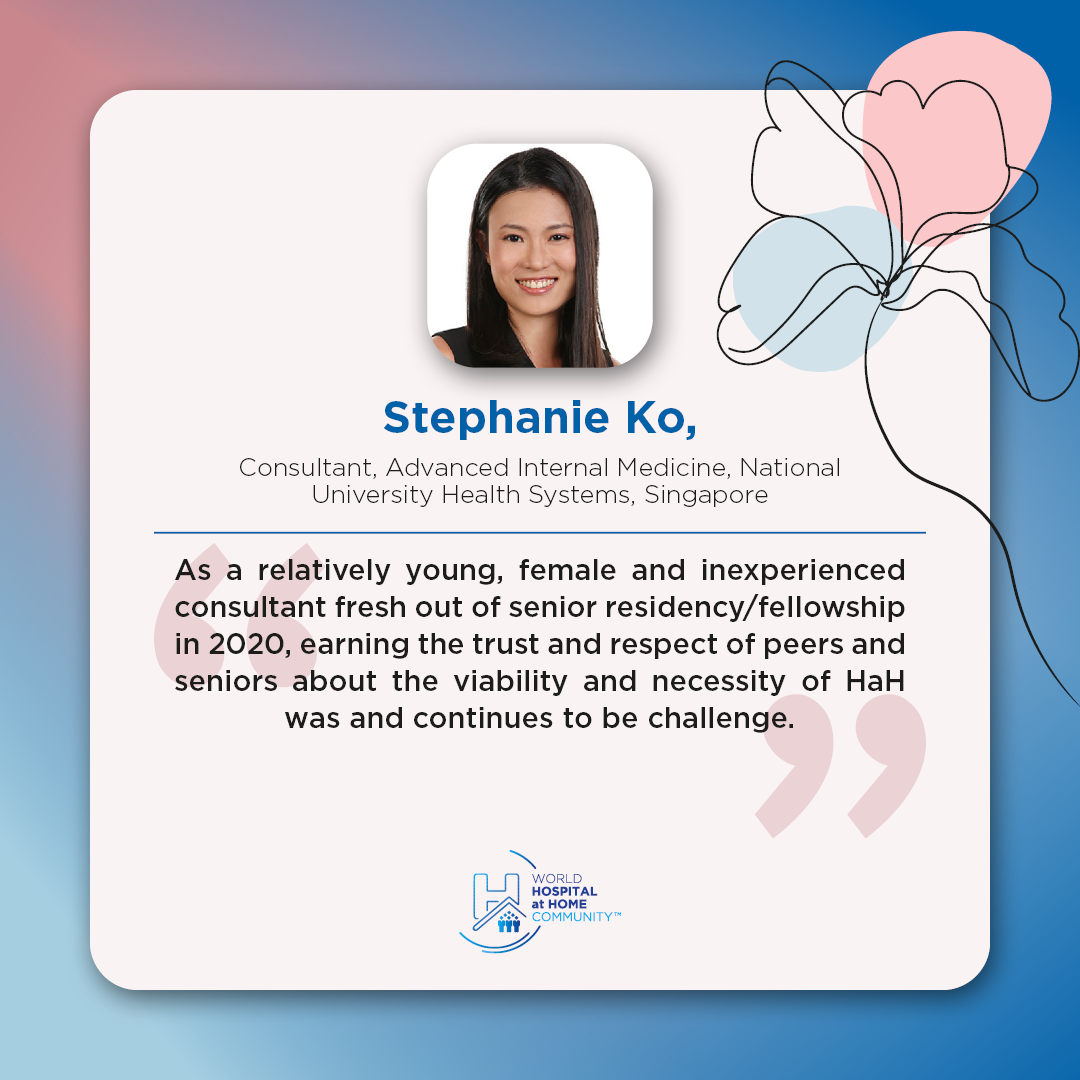
Stephanie Ko: The HaH journey requires complex stakeholder management including not only peers but healthcare leaders, which globally is a male-dominated field. As a relatively young, female, and inexperienced consultant fresh out of senior residency/fellowship in 2020, earning the trust and respect of peers and seniors about the viability and necessity of HaH was and continues to be a challenge. After some early success, our initial seed funding was almost running out after a year, and we had intended to discontinue the program. At the time, the COVID-19 Delta wave hit Singapore, renewing regulatory and financing interest in HaH. Now, HaH is set to be a mainstream component of Singapore's acute care landscape in April 2024. Although there is much more to be done, this milestone is a testament to the collective effort of multiple HaH units across Singapore, the Ministry of Health, and the Ministry of Health's Office of Healthcare Transformation; and personally serves as a reminder that with perseverance and belief (and a lot of luck), systemic changes are achievable.
Beatriz Massa: My first challenge was to leave my city (Madrid) and family and move to another city with the confidence of better job options. Fortunately...this happened! Another relevant challenge for me is to maintain permanent updating while proposing innovative solutions such as the implementation of a HaH unit, including pediatric and mental health care. In 2017, I was proposed as Director of the San Juan Hospital in Alicante (2017-2023), having to assume the management of the COVID-19 pandemic at the head of a company with almost 3,000 workers.
- Do you have a specific case or interesting story from your experience you would like to share?
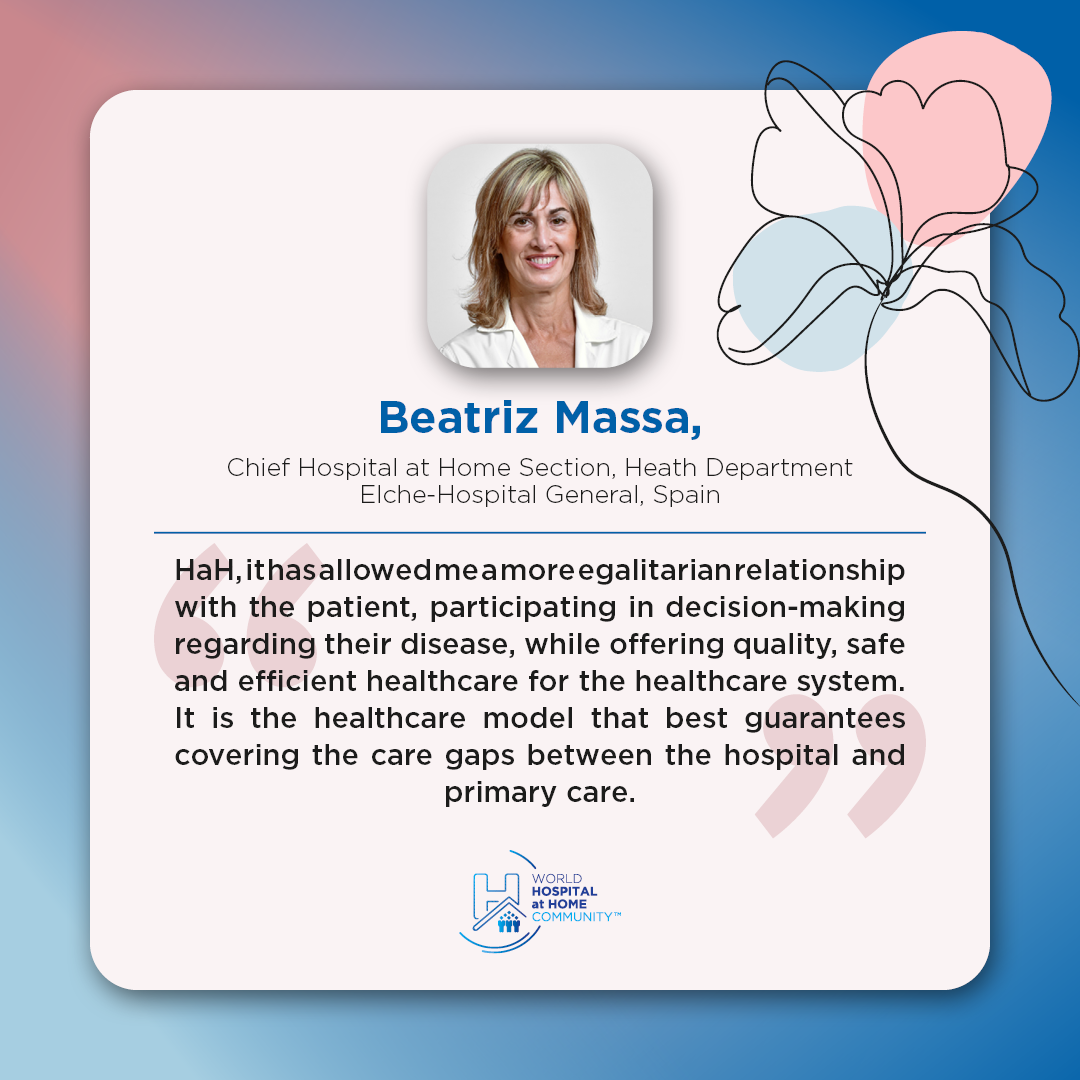
Karen Titchener: I have so many HaH patient stories it is hard to choose 1 to share so I have chosen 2.
There was a mother who presented to the Accident and Emergency Department with pyelonephritis. She had three young children, her husband worked nights, and the A&E doctors wanted to admit her for IV antibiotics, however, the mother refused as it would mean her children would have to go into care while she was in the hospital due to the fact she was a new immigrant and had no supporting family or support network to help look after the children. We admitted her to our HaH program, and that night I went out at 10 pm to admit her to the program and initial her IV abx. Although she was very unwell and symptomatic with her pyelonephritis, she was managing the children well and was so grateful to be admitted to the program. She was discharged after three days of IV abx.
A 63-year-old gentleman presented to the A&E with pneumonia. He was a chair-bound MS patient who was now requiring continuous O2 on 5l and when we spoke to him about HaH, he and his wife cried with gratefulness as they did not want to be admitted to the hospital. We were waiting for him at home as he arrived in the ambulance. We helped the ambulance crew transfer him to his bed, set up his O2, and IV infusion, and carried out the admission. Within 3 days the patient was up in his wheelchair and out in the garden watering the flowers. As we discharged the patient, he and his wife again expressed so much gratitude and said that normally when he is admitted to the hospital (which is at least twice a year) he has to go to a rehab facility for 4-6 weeks as he becomes so deconditioned from his hospital stay.
Vittoria Tibaldi: I am not sure I have a specific story to share. But what comes to my mind is, that when I started working in this service 25 years ago and went to a patient’s home with a male nurse, the patients almost always thought I was the nurse and he the doctor. This is an example of gender discrimination that today is a little less evident but still has not disappeared entirely.
I have, however, in general, good memories. The positive and beautiful aspect of this work is that we have the opportunity to create a strong connection with our patients and their families. This way of being a doctor I find very human.
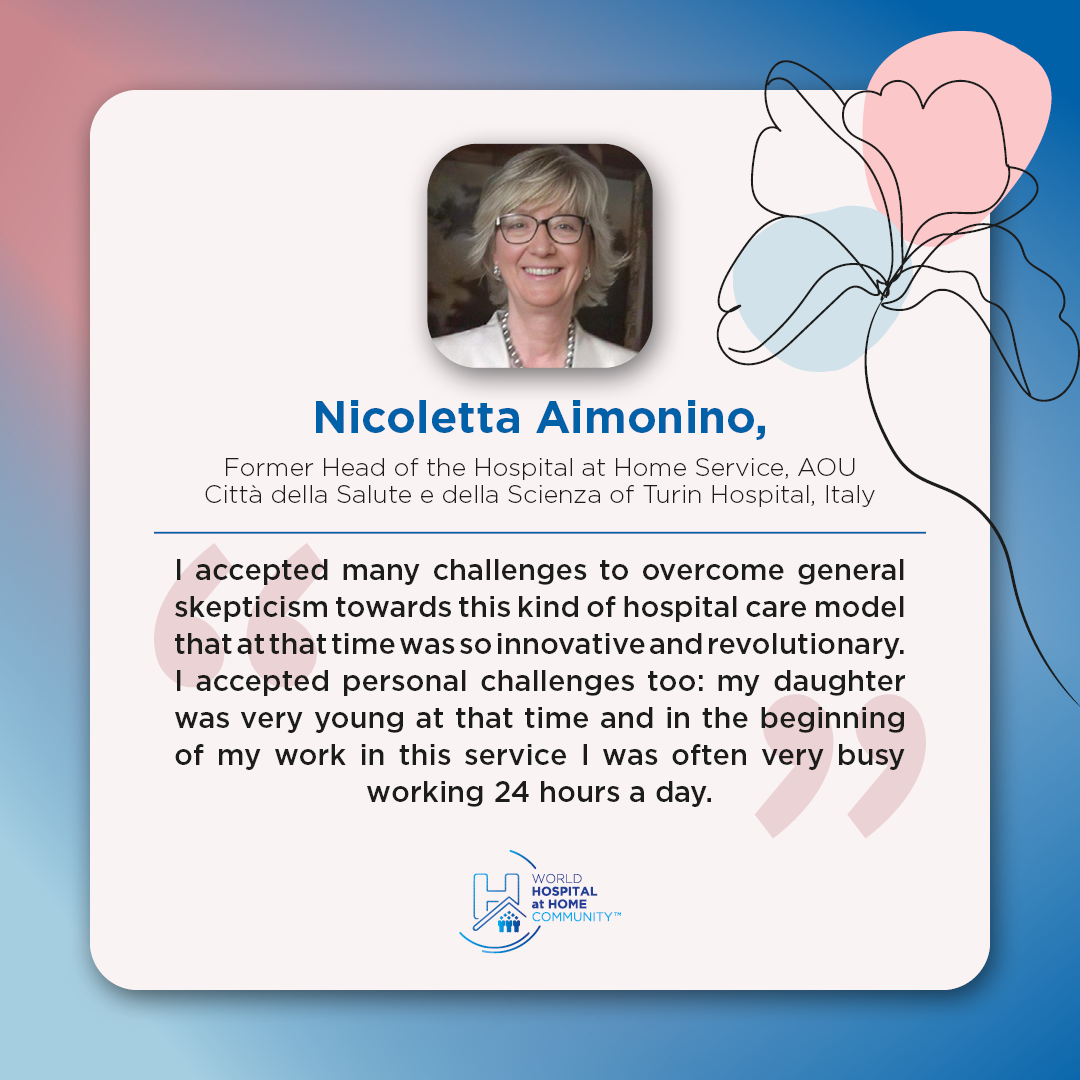
Nicoletta Aimonino: The most interesting challenge we overcame was to be recognized by the Official Resolution of the Regional Council of Piemonte in which the role of our HaH started to be economically supported. The meeting in 1990 with Vittoria Tibaldi, a young thesis student and a brilliant physician, was very important; she supported me very well not only in the daily activities but also in doing research related to the importance of the HaH services. The results of our research, published in a lot of important international magazines, allowed us to get in touch with wonderful people and exchange experiences with a lot of other HaH services around the world (Leff, Caplan, Montalto, etc.). Last but not least, in 2008 we started a new service of teleradiology, which is still operational.
Michelle Grinman: When we first started the program, I often felt that escalations in care requiring transfer back to the hospital were a failure of either our screening process or the ability to provide resources in the home. For one of these patients, I had to send him back to the hospital within 3 days of admitting him to HaH because his condition worsened unexpectedly, and we were no longer able to safely care for him at home. The entire team felt frustrated about this until a few months later when we received a card from his spouse thanking the HaH for those 3 days at home. She stated that those were the last 3 days he was able to be out of the hospital until he died a few months later, and they had both cherished that time together at home throughout the rest of his journey. This exemplified for me the impact that HaH can have on patients beyond the usual ways in which we measure success, and inspired our team to continue to strive for the highest quality of care.
Stephanie Ko: Two months after we started the HaH program, one of our patients developed a severe anaphylaxis episode at home unexpectedly. Thankfully the patient recovered well, but that episode was a learning experience for me. There was a lot of self-doubt about the program and systems that we developed, as well as my personal conviction in the care model and fear of licensing as a healthcare professional (after talking to lots of colleagues in the HaH field - this fear seems pretty common!) After lots of consultation with specialists, we refined our protocols and training, and now run anaphylaxis simulation exercises for all new staff.
Beatriz Massa: One afternoon in the spring of 2018, I received a curious phone call coming from Israel. A kind voice... was interested in the Spanish HaH model and proposed to me to get in touch because the interest in this care model aroused in his country. Dr Itamar Offer came into my life and just over a year later we met in Madrid in the 1st World Hospital at Home Congress. The rest... it's a great story!
- What piece of advice would you like to give to the women and all professionals in the field?
Karen Titchener: Lead by example by being a servant leader. Never ask anyone in your team to do something you are not prepared to do yourself- i.e. be a leader who is not afraid to roll their sleeves up and get the job done. I have been blessed to have worked with a few strong women leaders in my working life, who have mentored and directed me influencing how I have developed as a leader.
I highly recommend you seek out strong women leaders in HaH to work alongside who will believe in you and mentor and guide you.
Vittoria Tibaldi: I would suggest everyone, who wants to work in Hospital at Home be passionate, determined, curious, and open-minded. This is a field in which research still has much to discover, and where you are always pushed ahead. Working in a Hospital at Home always puts you to the test, but at the same time, it gives you so much satisfaction.
Nicoletta Aimonino: My advice to women working or interested in working in the field of HaH is to use their best qualities, i.e. tenacity, commitment, sharing, and empathy, both with patients and their relatives. I am also firmly convinced that continuous research is very important to keep the service up to date.
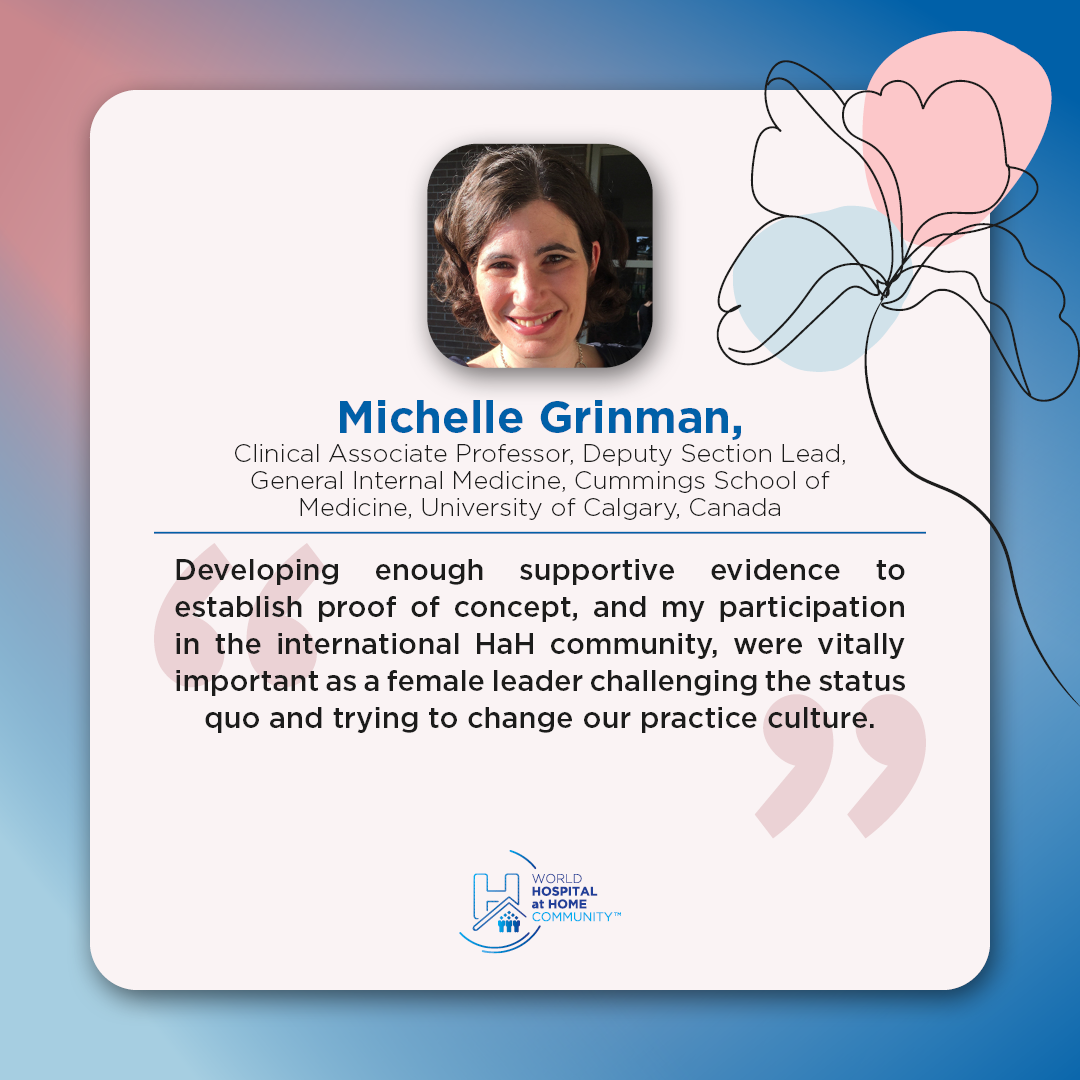
Linda DeCherrie: My biggest advice is, to find mentors - many mentors including peer mentors. They will help provide opportunities and provide advice.
Michelle Grinman: HaH is a fascinating and emerging field, but it is still not the standard of care in many jurisdictions. When developing new approaches, there will always be those who support you and those who will resist change. I find that I always learn an enormous amount from those who resist the new care model because their concerns highlight barriers and help me develop the program’s safety criteria. Also, once I address their concerns, they often become allies in the program’s journey. To lead the development of a new model of care, you need to be tenacious, curious, and collaborative. When you encounter the inevitable challenges of changing the way care is delivered, don’t assume a problem is insurmountable, instead try to think about the problem differently or engage different stakeholders that may unlock a potential solution.
Sophie McGlen: Find your passion and work hard to achieve it. Working in an innovative field such as Hospital at Home will always draw criticism, but this should never stand in your way of implementing innovation or solutions that help deliver truly great care to our patients at home.
Stephanie Ko: When given the opportunity, it's normal to be intimidated but we should own our place and be proud of it. Two specific moments stand out to me - once at a COVID appreciation dinner as the only female and youngest at a table of ten, and second as the only female on a conference discussion panel. In both circumstances, I was intimidated and doubtful of whether I had substance or included as representation, but ultimately I chose to embrace the situation with sincerity and a firm commitment to advocating for what I believed was right.
The HaH field, like many areas of healthcare, is paved with both obstacles and opportunities. One of the most rewarding experiences in the HaH field is the openness and willingness of HaH colleagues to always share experiences and knowledge, building a really positive international community. To fellow women and colleagues in the field, let's continue to push boundaries, drive change, and inspire the next generation of healthcare professionals.
Beatriz Massa: One piece of advice would be to work as much as you consider necessary, without forgetting that for others to value your work... you must first value yourself. Be honest with yourself and don't forget your values, especially when circumstances are not the most favorable. Don’t forget that patients and their families must be always the goal of our daily practice.
|